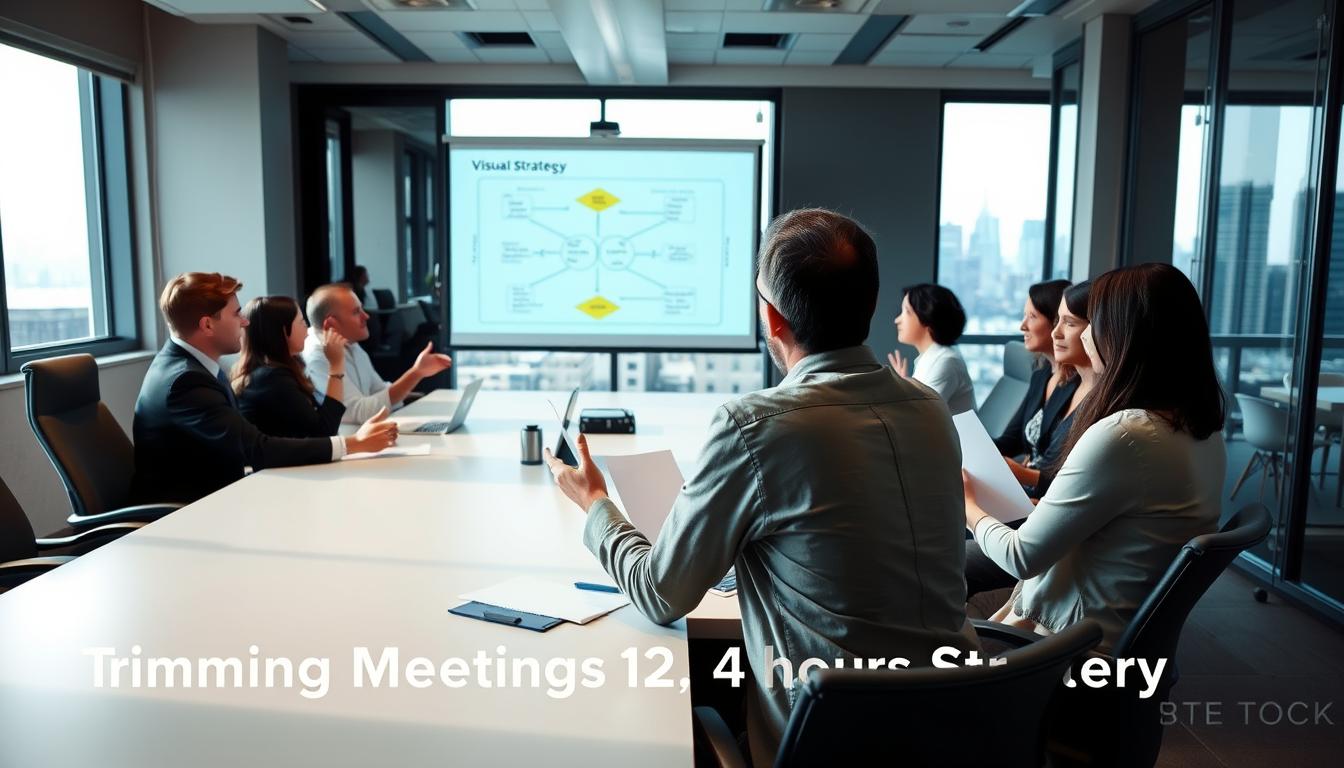In today’s speedy work world, cutting down time wasted in meetings is key to more productivity and better teamwork. Organizations need to see the value in making meetings more efficient. Too many meetings can make us lose focus on the real work, leading to stress and low spirits among team members.
By learning how to manage meetings well, teams can communicate better and work more smoothly. This piece explores why we have too many meetings and the downsides of this. It gives handy tips for improving meeting practices.
What Is Meeting Overload?
Meeting overload happens when there are too many meetings. It makes people less productive. Meetings should help with work, but sometimes they just waste time. This makes it hard for everyone to do their main jobs and slows down important work.
The problem with too many meetings is they take up a lot of time. It also messes up the balance between work and home life. When people have to join too many meetings, they can’t focus on their important tasks. This makes the whole team less effective and happy.
Why Does Meeting Overload Happen?
Meeting overload starts from many things that stop us from being productive. A big reason for meeting overload is not having clear agendas. Without a specific plan, talks can go off track, wasting time on things that don’t matter.
Not figuring out which meetings are most important also plays a part. Teams might set up meetings for every little thing, no matter if it’s urgent or not. Seeing meetings as the answer for everything makes it hard to find time for real work.
Problems with remote work make us have more meetings, too. With teams working online, it’s common to have lots of virtual check-ins. Even though these are meant to help us talk better, they often lead to too many meetings. This could be solved with emails or teamwork tools instead.
Another issue is keeping old meeting habits without asking if they’re still needed. Lots of companies keep having meetings that don’t help anymore. We need to think carefully about why and when we have meetings to use our time better.
The Hidden Cost of Too Many Meetings
Too many meetings can really slow down a company. Studies show that over 35% of middle managers’ workweek is taken up by meetings. Often, these do not even help with work. Spending so much time in meetings can make workers feel overwhelmed and stressed.
Many meetings interrupt workers throughout the day. This makes it hard for them to concentrate on their main jobs. Feeling disconnected and frustrated, they lose the drive to work hard. This can lead to the whole team not doing as well as they could.
Meetings that aren’t needed can also cost a company a lot of money. They lead to lost work time, making it harder to manage the budget. If workers are stuck in meetings instead of doing their jobs, it uses up resources and lowers the company’s efficiency.
Identifying Signs of Unproductive Meetings
Spotting signs of ineffective meetings is key to making them better. If meetings lack clear goals, people get confused and the discussion may go off track. Not being ready means time is lost as attendees try to catch up or sort out problems that should have been fixed before.
Bad time management is another warning sign. When meetings go on too long, people get upset and lose interest. Plus, if there’s no solid plan, talks can wander off topic without leading to real results.
Having the right people in the meeting matters a lot. When engaged folks contribute, it makes the conversation richer and helps make better decisions. But if meetings are just for show and leave out key people, nothing useful comes from them.
Skipping the step of making follow-up plans is a big mistake. Without clear tasks and assigned roles, whatever was talked about can end up being pointless. This leaves problems unsolved and wastes everyone’s time and effort.
Research shows that bad meetings cost businesses a lot of money every year. By looking closely at how meetings are run, companies can spot these issues. This allows them to make meetings more effective and engaging for everyone involved.
Practical Strategies to Reduce Meeting Overload
Putting in place smart strategies can make meetings more effective. This helps ensure every meeting is worth the time and boosts productivity. Here are ways to make meeting processes better.
Define Meeting Purpose
Every meeting needs a clear goal. Knowing the specific aim sharpens the focus. It helps people get ready and use time well.
Audit Current Meetings
Checking your meeting schedule regularly helps find meetings you don’t need. Figuring out which ones to change or drop makes things more efficient. Doing this frees up time for important tasks.
Develop Meeting Guidelines
Setting rules for meetings about how long they last and who should attend helps. These guidelines make meetings run smoother. Everyone knows what to expect.
Cancel Meetings that Aren’t Required
It’s good to only have meetings that are really needed. Always check if you still need regular meetings. If not, cancel them to avoid wasting time.
Effective Meeting Practices
Adding good meeting habits can greatly boost how well internal talks go. Starting on time shows you value everyone’s time and promotes being punctual in the whole group. This not only makes things more professional but also makes sure everyone is responsible.
Start on Time
It’s important to begin meetings right when they’re supposed to start to use time wisely. If everyone shows up on time, conversations are smoother, making the meeting more fruitful. This sets a strong foundation for good meeting habits, respecting everyone’s schedules.
Role of a Facilitator
A good facilitator is key in leading discussions, keeping focus, and making sure everyone has a chance to speak. They manage the talk, bring in different ideas, and keep things on track if they stray. This makes meetings better and ensures everyone is heard.
Techniques for Engaging Participants
Using active methods helps make meetings more interactive. Getting everyone involved can include brainstorming, live polls, and asking for feedback. These approaches keep everyone engaged and promote teamwork. By doing this, meetings can lead to more meaningful outcomes.
Tools & Technology for Meeting Management
Choosing the right tools and technology can change how meetings are done. These tools help teams talk better and plan easier. This saves time
that might be lost in long chats. Thus, teams can focus on what’s really important for productive talks.
Collaboration Platforms
Platforms like Slack and Microsoft Teams allow for chatting and sharing files right away. They help teams solve problems and update each other without many meetings. Using these daily can make team work smoother and keep everyone informed.
Integrated Calendars
Tools like Google Calendar make scheduling simple by showing when everyone is free. They help avoid planning mistakes and only set meetings when needed. These calendars also remind you of meetings and show agendas quickly.
Real-time Collaboration Tools
Tools like Miro and Figma are great for working together on creative projects. They make meetings fast and to the point. With features for planning and sharing documents, teams can get ready for meetings better, making conversations more meaningful.
Reduce Time Wasted in Internal Meetings
To cut down on meeting time, companies need clear plans to make internal meetings more efficient. They should start by setting the agenda clearly. This way, everyone knows what the meeting is about. Having a clear purpose helps everyone stay focused and have more productive talks.
Using timeboxing helps make sure each topic gets only a set amount of time. This approach encourages everyone to be brief and keeps discussions on point.
Asynchronous communication is another way to boost efficiency. Team members can use emails or project management tools to share information before meetings. This reduces the need for long discussions during the meetings themselves.
It’s also helpful to ask for feedback on how meetings are going. Leaders can figure out what’s working and what’s not. This helps them decide what to keep or change for future meetings.
Benefits of Streamlined Communication Due to Fewer Meetings
Having fewer meetings can greatly benefit work life by boosting productivity and morale. With more direct communication, employees get more engaged. This lets them focus on their main tasks without being disrupted.
Increased Employee Satisfaction
Less frequent meetings make employees feel less stressed. By cutting down on needless talks and focusing on important ones, staff can better focus on their work. This boosts their satisfaction and creates a happier work environment.
Better Work-Life Balance
Frequent meetings make it hard for employees to balance work and personal life. By reducing meeting time, they can spend more time on hobbies and with family. A good balance improves their overall happiness and job contentment.
Enhanced Team Collaboration
Teams communicate better when interruptions from meetings drop. With fewer disruptions, employees work together more effectively. This helps in solving problems and coming up with new ideas. Stronger teamwork leads to a stronger organization.

Conclusion
It’s very important for any group wanting to do well to have efficient meetings. As this article shows, too many meetings can really slow things down. They take up a lot of time and resources, hurting how much gets done.
To fix too many meetings, businesses need to look closely at how they handle meetings. Adopting the tips we talked about, like making sure meetings have a clear purpose, checking on the meetings you already have, and using tech well, can really help teams talk better. Seeing when meetings aren’t helping and building a work culture that values working well together can make work more fun and engaging.
In the end, fixing too many meetings is something companies should focus on. By working on making meetings better, businesses can get more done and make their employees happier. Let’s all work towards having meetings that are useful and respect everyone’s time, making the workplace better for everyone.



